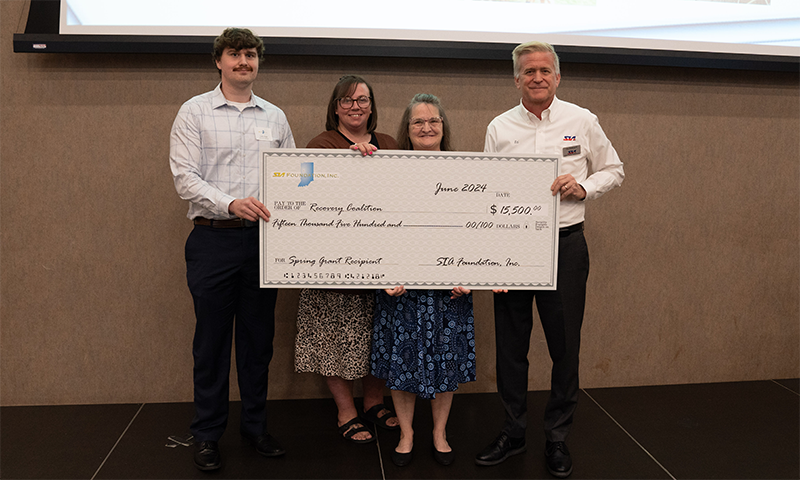The Recovery Coalition of Montgomery County was awarded a grant from Subaru of Indiana Automotive (SIA) to build a new playground, thanks to a partnership with Associate Professor of English Crystal Benedicks and her students in ENG-302 "Writing in the Community: Grants & Nonprofits.”
The playground will offer a safe environment for children whose families are receiving services from Recovery Coalition.
The Recovery Coalition helps provide a healthy, drug-free community for those in Montgomery County in recovery from addiction by offering self-help meetings, 12-step groups, free meals, and more at its Recovery Rec Center. It strives to make services as accessible as possible, which includes offering childcare during community activities.
 “We have a daycare room, but kids need fresh air. They need to run and play,” said Recovery Center Director Connie Esra. “The playground will be used so that our daycare providers can take the kids outside and have plenty of activity.”
“We have a daycare room, but kids need fresh air. They need to run and play,” said Recovery Center Director Connie Esra. “The playground will be used so that our daycare providers can take the kids outside and have plenty of activity.”
Benedicks had the idea for a new writing class several years ago, when she became disheartened by the lack of “real-world” impact her English classes were having.
“It seemed like writing in college is just a cycle of students producing papers about topics I told them to write about. It just seemed so sterile,” Benedicks said. “I was trying to think about what would be real writing people could do — actual writing that would matter in the world — and that’s when I thought of grant-writing.”
Students in the class connect with a specific local organization, then the structure of the class is determined by the wants and needs of each organization and how the students can best help it achieve its goals.
“Some years, community partners want a website, posters, or an informational pamphlet designed or help with their social media presence, and some years they just ask us to find them some money,” Benedicks said. “I love teaching the class, because it is exciting, and you don't know what's going to happen at the beginning.”
The Recovery Coalition, which celebrates its six-year anniversary in July, surprised the class with a unique request: a playground.
“We have a family and friends meeting every Tuesday for people affected by the addictive behavior of a loved one,” Esra said. “You can bring your kids, and now they’ll have the outside play equipment that can occupy their time so the adults can have conversations about the things they are struggling with trying to help a loved one that is struggling with a substance use disorder.”
“If there's a playground, the children are on the playground having fun, and that means people can stay at the Recovery Center longer,” Benedicks explained. “The whole ethos of the place is family. This helps create that feeling of families being happy together.”
While the Recovery Coalition had long been interested in a playground, Coalition staff didn’t know where or how to start looking, until meeting with the Wabash students.
Since the class structure adapts to each project, Benedicks and her students started by visiting and volunteering with the Recovery Center administrators to identify their needs.
“The moment the director of the Recovery Coalition mentions playgrounds, one of the guys has his phone out researching playgrounds,” Benedicks said. “There was all of this energy around it, and the students just ran with it.”
As the students began planning for the grant, they decided they wanted to conduct interviews with people who use the Recovery Center’s services to better understand their needs and to help tell a more compelling story in the grant.
“They designed flyers explaining what they were doing, passed those flyers around, and found some people to talk with them,” Benedicks said. “That information got used in the SIA grant and was one of the things that was so effective. It was about more than just asking for the money; it was telling the stories of the people this will impact.”
Benedicks believes the class is extra rewarding, because students can get involved in the community and see the impact of their work.
“The students in the class get invested in the projects in a way they might not if you're just writing a paper for a grade,” Benedicks said. “So much of this class happens outside of the classroom. So much of it happens in community spaces, where I think it's not likely that students would go unless they have a reason.”
Once the students decided the SIA grant was the best fit, the two student co-authors of the grant workshopped the write-up with the class several times over until they were confident in their submission.
Two weeks after the school year ended, they found out the grant had been awarded.
Although their proposal was one of only 16 to be accepted out of 399 submitted, Benedicks was always confident in the ability this class had to have a tangible impact on the community.
“The students knew it was a long-shot grant, but they thought they had a compelling story to tell,” Benedicks said. “They shared that information and made the best case they could.
“And they’re good writers,” she added.
“There’s no way we could have done it without the Wabash students,” Esra said. “They wrote the grant for us; they sent it in for us; they did it all.”